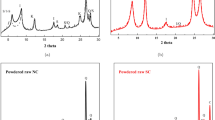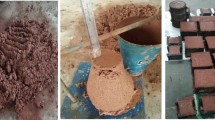Abstract
The present study examines the role of micro-structure on the compressive strengths of geopolymers using mercury intrusion porosimetry technique. Geopolymers were synthesized from pozzolanas such as, class-F fly ash, kaolinite, metakaolinite, ground granulated blast furnace slag and red soil. Geopolymer reactions were accomplished by alkali activation of the pozzolanas using 10 M NaOH solution at 100 °C for 7-days. The geopolymers exhibited tri-modal nature of pores i.e., macro-pore mode (entrance pore radius: 25–5000 nm), meso-pore mode (entrance pore radius: 1.25–25 nm) and air void mode (entrance pore radius >5000 nm). The micro pores (entrance pore radius <1.25 nm) do not contribute to porosity of the geopolymers. The fly ash geopolymer exhibited largest total intruded volume (0.3908 cm3/g), while the red soil geopolymer exhibited the least intruded volume (0.0416 cm3/g). Interestingly, geopolymers with higher intruded volumes were characterized by larger compressive strengths. The experimental results also indicated that geopolymers with larger air voids + macro pores volume exhibited superior compressive strength; the results imply that geopolymers which develop an open microstructure during polymerization are characterized by larger compressive strength, possibly from stronger bond formation in the silico aluminate structure.







Similar content being viewed by others
References
Hardjito D, Rangan BV (2005) Development and properties of low-calcium fly ash-based geopolymer concrete. Research Report GC1, Perth, Australia, Faculty of Engineering, Curtin University of Technology
McCaffrey R (2002) Climate change and the cement industry. Global Cement and Lime Magazine (Environmental special Issue), pp 15–19
Davidovits J (1994) Global warming impact on the cement and aggregates industries. World Resour Rev 6:263–278
Daniel K, Jay S, Kwesi S (2007) Comparative performance of geopolymers made with metakaolin and fly ash after exposure to elevated temperatures. J Cem Concr Res 37:1583–1589
Davidovits J (1991) Geopolymers: inorganic polymeric new materials. J Therm Anal 37:1633–1656
Duxson P, Fernandez-Jimenez A, Provis JL, Palomo GCA, Van Deventer JSJ (2007) Geopolymer technology: the current state of the art. J Mater Sci 42:2917–2933
Komnitsas K, Zaharaki D (2007) Geopolymerization: a review and prospects for the minerals industry. J Miner Eng 20:1261–1277
Andini S, Cioffi R, Colangelo F, Montagnaro F, Santoro L (2008) Adsorption of chlorophenol, chloroaniline and methylene blue on fuel oil fly ash. J Hazard Mater 157:599–604
Bakharev T (2005) Geopolymer materials prepared using class F fly ash and elevated temperature curing. J Cem Concr Res 35(6):1224–1232
Slavik R, Bednarik V, Vondruska M, Nemec A (2008) Preparation of geopolymer from fluidized bed combustion bottom ash. J Mater Process Technol 200:265–270
Rattanasak U, Chindaprasirt P (2009) Influence of NaOH solution on the synthesis of fly ash geopolymer. J Miner Eng 22:1073–1078
Winnefeld F, Leemann A, Lucuk M, Svoboda P, Neuroth M (2010) Assessment of phase formation in alkali activated low and high calcium fly ashes in building materials. J Constr Build Mater 24(6):1086–1093
Xu H, Van Deventer JSJ (2000) The geopolymerisation of alumino-silicate minerals. Int J Miner Process 59(3):247–266
Xu H, van Deventer JSJ (2002) Geopolymerisation of multiple minerals. J Miner Eng 15(12):1131–1139
Van Jaarsveld JGS, van Deventer JSJ, Lukey GC (2002) The effect of composition and temperature on the properties of fly ash- and kaolinite-based geopolymers. J Chem Eng 89(1–3):63–73
Lloyd N, Rangan V (2009) Geopolymer concrete; sustainable cement less concrete. In: Proceedings of the 10th ACI international conference on recent advances in concrete technology and sustainability issues, Seville, ACI SP-261, pp 33–54
Provis JL, Rose V, Winarski RP, Van Deventer JSJ (2011) Hard X-ray nanotomography of amorphous aluminosilicate cements. Scr Mater 65(4):316–319
Provis JL, Myers RJ, White CE, Rose V, Van Deventer JSJ (2012) X-ray microtomography shows pore structure and tortuosity in alkali-activated binders. J Cem Concr Res 42(6):855–864
Ma H (2014) Mercury intrusion porosimetry in concrete technology: tips in measurement, pore structure parameter acquisition and application. J Porous Mater 21:207–215
Ye G (2003) The microstructure and permeability of cementitious materials. Ph.D. thesis, Delft University of Technology, Delft
Galle C (2001) Effect of drying on cement-based materials pore structure as identified by mercury intrusion porosimetry—a comparative study between oven-, vacuum-, and freeze-drying. J Cem Concr Res 31:1467–1477
ISO 15901-1 (2005) Evaluation of pore size distribution and porosimetry of solid materials by mercury porosimetry and gas adsorption, part 1: mercury porosimetry. International Organization for Standardization, Geneva, pp 6–9
Rouquerol J, Baron G, Denoyel R, Giesche H, Groen J, Klobes P (2012) Liquid intrusion and alternative methods for the characterization of macro porous materials (IUPAC Technical Report). J Pure Appl Chem 84:107–136
IS 1727 (1999) Methods of tests for pozzolanic materials. Bureau of Indian Standards, New Delhi
IS 2720 Part III, sec I (1980) Methods of test for soils: part 3: determination of specific gravity—fine grained soils. Bureau of Indian Standards, New Delhi
IS 2720 Part 4 (1985) Methods of test for soils: grain size analysis. Bureau of Indian Standards, New Delhi
IS 2720 Part 26 (1987). Methods of test for soils: determination of pH value. Bureau of Indian Standards, New Delhi
IS 2720 Part 21 (1977) Methods of test for soils: determination of total soluble solids. Bureau of Indian Standards, New Delhi
Todd DK (1980) Groundwater hydrology, 2nd edn. Wiley, New York
Rao SM, Acharya IP (2014) Synthesis and characterization of fly ash geopolymer sand. ASCE J Mater Civil Eng 26:912–917
Hoffman GK, Jones GE (2005) Availability of coal resources in the Vermejo and Raton formations, Raton coalfield, Raton Basin, northeast New Mexico, New Mexico Bureau of Geology and Mineral Resources Open-file report 490
Ward RC, French D (2006) Determination of glass content and estimation of glass composition in fly ash using quantitative X-ray diffractrometry. J Fuel 85(16):2268–2277
Ward RC, French D (2005) Relation between coal and fly ash mineralogy based on quantitative XRD methods. In: World of coal ash Conference (WOCA), April 11–15, Lexington, KY, USA
Kolay PK, Singh DN (2001) Physical, chemical, mineralogical and thermal properties of cenosphere from an ash lagoon. J Cem Concr Res 31:539–542
Bagchi SN (1951) Minerals present in hydrogen clays from Indians soils, kaolins and bentonites. Bull Indian Soc Soil Sci 6:19–41
Ghosh SK, Das SC (1963) Nature of minerals in the soil clays of some red soils of Ranchi. J Indian Soc Soil Sci 11:69–72
Sinha MK, Mandal SC (1963) A mineralogical study of some acidic red loam soils of Chotanagpur. J Indian Soc Soil Sci 11:329–332
Lefebvre G, Delage P (1986) The use of mercury intrusion porosimetry for the analysis of clay microstructure. In: Balasubramanian AS, Chandra S, Bergado DT (eds) Recent developments in laboratory and field and analysis of geo-technical problems, Bangkok. Balkema, Rotterdam, pp 31–43
Acknowledgements
The authors thank DST-FIST Program, Government of India for funding the MIP equipment.
Author information
Authors and Affiliations
Corresponding author
Rights and permissions
About this article
Cite this article
Rao, S.M., Acharya, I.P. Mercury Intrusion Porosimetry Studies with Geopolymers. Indian Geotech J 47, 495–502 (2017). https://doi.org/10.1007/s40098-017-0245-7
Received:
Accepted:
Published:
Issue Date:
DOI: https://doi.org/10.1007/s40098-017-0245-7




